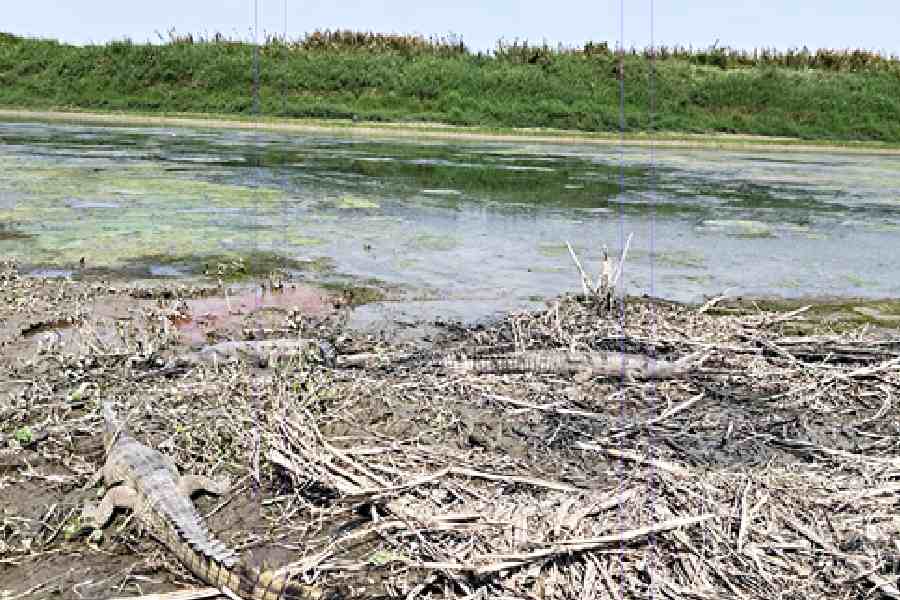Gharials that were artificially hatched in a zoo in Cooch Behar have found a new home in “no man’s land” in the tributary of the Padma on the India-Bangladesh border.
Thirty-seven gharial (Gavialis gangeticus) babies, commonly known as fish-eating crocodiles, were released by forest department officials near Tiktikipara village in Murshidabad’s Jalangi block, around 50km from Behrampore, on Saturday morning. It is a riverine habitat of the Ganges, said experts.
The relocation was possible only after local fishermen were convinced that the gharials would not consume all their fish.
“The villagers, mostly fishermen, were concerned that the gharials would eat fish and create a shortage for them. Since gharial is a schedule 1 species, they were also worried that if the fishermen or villagers kill the reptiles by accident, they would face imprisonment and financial penalties,” a forest official said.
The state forest department for the first time successfully bred 42 gharial hatchlings by preserving the eggs laid by the species in an artificial environment at the mini zoo at Rasikbeel, Cooch Behar district.
Pradip Bauri, the divisional forest officer (DFO) of Murshidabad, said: “This is also the first time that so many artificially incubated gharials have been released in the wild in Bengal.”
The gharials are a year and eight months old on average. They weigh between 0.8kg and 5kgs and are between 135cm and 211cm in length, said a forest official.
They have been tagged with microchips for later reference.
“The deliberations for releasing the gharials were going on since last year. A suitable place for releasing the endangered species was being discussed,” said a forest department official.
“The gharials need fresh, fast flowing and deep water. Also, there should be an abundance of fish for their diet and sandbanks where they can lay eggs,” he said.
After long deliberations, the Murshidabad district administration agreed to help the forest department in releasing the gharials.
“The tributary seemed ideal as a habitat for the gharials,” said a forest official.
The gharial is categorised as a “critically endangered” species by the International Union for Conservation of Nature (IUCN). It is protected under Schedule I of the Wildlife (Protection Act) 1972. The Bengal tiger (Panthera tigris), also accorded the same protection status, is categorised as “endangered” by the IUCN.
Rajarshi Mitra, the district magistrate of Murshidabad, said: “The local fishermen had some initial reservations. The forest department and local administration talked to them. Once they understood the importance of the project and their fears were allayed, everything went off smoothly. There is plenty of water in the Padma. It has enough to sustain the gharials as well as the fishing community.”
On Saturday, the gharials were carried near the river in a lorry and from there to the banks on pick-up vans. The gharials were in PVC pipes with lids.
A WWF team would be tracking the gharials for the next fortnight, said a forest official.
Gharials are part of the crocodile family and distinguished by their long and thin snouts. They live in clear freshwater river systems and feed mainly on fish.
“This started as a pilot project two years ago in Cooch Behar’s Rasikbeel. Gharial eggs were kept in artificial incubation. The babies that hatched from the eggs were kept there for a little less than two years. A device was built for the transportation of the babies. It is like a pipe with two ends sealed and perforated in between,” said Debal Ray, the chief wildlife warden of Bengal.
The main threat to gharials is the loss of habitat and fragmentation of water bodies, he said.
“A critical decline in population usually leads to local extinction. From several places in the riverine habitat of Bengal, gharials are as good as extinct. The sightings are very few and far between,” said Ray.
Subrat Kumar Behera, project head, Gandak Gharial Recovery Project, Wildlife Trust of India, said the construction of dams and reservoirs was one of the main threats to the gharial population.
“The number of breeding sites has dwindled significantly,” Behera said.
He welcomed the conservation project in Bengal.
“Just artificial incubation or releasing the babies don’t mean much. A detailed feasibility study of the habitat is imperative before release. After release, there should be periodic audits of the habitat and the gharials. It is a continuous process,” he said.
